The UN conference on Sustainable Development in Rio de Janeiro in 2012 set out to achieve a set of 17 universal goals to overcome some of the most urgent environmental, political and economic challenges faced by the world. These goals are complemented by 169 targets and associated indicators to measure performance and progress. The implementation began in 2015 and the goals are targeted to be achieved by 2030. The progress achieved by 2021 should help in manoeuvring and steering targets in a manner that the goals are achieved by 2030.
SDG Index for India by NITI Aayog
NITI Aayog, the public policy think tank of Government of India developed a composite index in 2018, to track the SDG progress at a national and subnational level by extensive collaboration with Ministry of Statistics and Program Implementation’s ‘National Indicator Framework (NIF)’, State governments and other UN agencies.
There was no index report published in 2017. In 2018, the report published details on 13 goals, 39 targets and 62 indicators. In 2019, while the number of goals remained 13, targets coverage was increased to 54 and 100 indicators were covered. No index report was published in 2017 and 2020 as
Index Report 2021: What’s new
The third and latest report in this series in 2021 covers all 17 goals, 70 targets and 115 indicators which makes it the first report with full coverage of all goals. The 2021 report, which is one of the most comprehensive reports till date, also developed an interactive state-wise dashboard to allow easy access to this data. The raw data collected at the state level is used in various formulae, normalised and rescaled to develop a final score for each indicator on a scale of 0-100.
Three categories convey the status of SDGs, which is aspirant for score of 0-49, performer with a score of 50-64, front runner with a score of 65-99 and finally achiever with a score of 100. What is intriguing is that aspirant category has scores from 0-49, and to move out of that category may require considerable work.

State/UTs: Track Record
Over the course of time most of the states have upgraded from the category of performer to frontrunner. Kerala, Chandigarh, Tamil Nadu and Himachal Pradesh have been the top performers and maintained the status of frontrunner since 2018. Madhya Pradesh, Chhattisgarh and Arunachal Pradesh have remained in the performer category since the beginning. Mizoram, Haryana and Uttarakhand have gained the highest points in terms of improvement in this reporting period. While Sikkim had improved from performer to frontrunner and relapsed back to performer. Over the years, Bihar has shown the biggest improvement by moving from the category of aspirant to frontrunner.
India’s Progress: Overview
India has made a marginal improvement in its SDG performance in 2021. There has been a rise of the total average score of India from 60 in 2019 to 66 in 2021. While in 2019 only 10 states belonged to the frontrunner category, 12 more states have achieved the frontrunner category in 2021. Despite no state reaching the achiever category, it is comforting that all Indian states have moved out of aspirant category. While SDG 2 and SDG 5 demand special attention due to an overall low score, the country has progressed in 9 out of the 16 SDGs.
Let’s stay tuned in knowing more about performance of each SDG and understanding how the scoring works.
The individual SDGs will be discussed in the upcoming blog articles in this series titled ‘The State of India’s Progress on SDGs’. The NITI Aayog reports will be used to analyse the relevant targets, the indicators considered and the performance of each state over the years. The national and sub-national performance on each SDG will be critically assessed. This will provide the reader with an in-depth understanding to identify state-wise focus areas for SDGs and gain useful insights.

